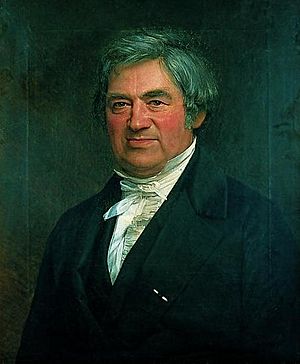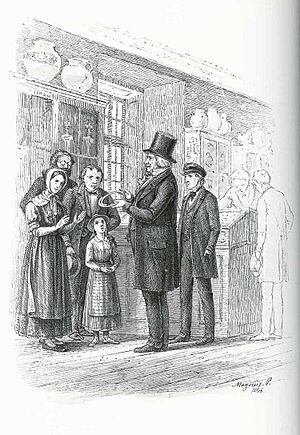Christian Jürgensen Thomsen facts for kids
Quick facts for kids
Christian Jürgensen Thomsen
|
|
|---|---|

J. V. Gertner, Christian Jürgensen Thomsen, 1849
|
|
| Born | 29 December 1788 Copenhagen, Denmark
|
| Died | 21 May 1865 (aged 76) Copenhagen, Denmark
|
| Nationality | Danish |
| Known for | Introducing the three-age system |
| Scientific career | |
| Fields | Archeology Museum administration |
Christian Jürgensen Thomsen (born December 29, 1788 – died May 21, 1865) was a Danish expert in old objects. He created important early methods for archaeology, which is the study of human history through digging up old things.
In 1816, Thomsen became the head of the "antiquarian" collections. These collections later grew into the famous National Museum of Denmark in Copenhagen. While organizing these ancient items for display, he decided to arrange them in order of time. He used a system called the three-age system. Other experts had thought that early human history moved from using stone tools, to tools made of bronze, and then to tools made of iron. But these ideas were just theories about how things developed. They didn't help to figure out the exact age of artifacts.
Thomsen made the three-age system much better. He turned it into a way to date objects. He did this by looking at which artifacts were found together in "closed finds." These are places where items were buried at the same time and haven't been disturbed. By doing this, he was the first to show, with real evidence, that prehistory could be divided into clear time periods. Because of this big achievement, he is known for creating the three-age system for ancient Europe.
Thomsen also wrote one of the first detailed studies about gold bracteates. These are thin, round gold pendants from the Migration period. His studies at the Copenhagen museum looked at how styles changed, how things were decorated, and where they were found. He understood how important it was to study objects from "closed finds." This helped him figure out which common artifacts belonged to the Stone, Bronze, and Iron Ages. He published his findings in a book called Ledetraad til Nordisk Oldkyndighed (Guideline to Nordic Antiquity) in 1836. An English version came out in 1848.
Contents
Early Life and Interests
Christian Jürgensen Thomsen was born in Copenhagen in 1788. His family was wealthy and involved in trade. When he was young, he visited Paris. After returning to Denmark, he became very interested in collecting coins. This hobby likely helped him learn how to spot changes in style over time. This skill was very useful later in his work with ancient artifacts.
How Thomsen Changed Archaeology
In 1816, Thomsen was chosen to manage the first exhibition for the Danish Royal Commission for the Collection and Preservation of Antiquities. This job didn't pay a salary. So, Thomsen's own money and his experience as a coin collector were his main qualifications.
Thomsen likely knew about the three-age idea from other scholars. He decided to sort the museum's collection by time period. Before Thomsen, people might have just sorted items by what they were made of or how well they were crafted. But Thomsen knew where many items came from. He saw that simple artifacts were sometimes found with fancy ones. Also, metal items were found with stone items. Instead of just looking at technology or how things evolved, he realized his job was to figure out when the artifacts were made.
Thomsen decided to map out what kinds of objects were found together and what were not. This helped him see patterns that belonged to certain time periods. For example, he found that stone tools were often found with amber, pottery, and glass beads. Bronze items were found with both iron and gold. But silver was only found with iron. He also noticed that bronze weapons were never found with iron artifacts. This meant each period could be defined by its main cutting material.
He also saw that items buried with people changed depending on the type of grave. Stone tools were found with uncremated bodies and stone-chamber tombs. Bronze weapons and lurs (ancient horns) were found in stone-schist graves. Iron items were found in chamber tombs inside barrows (burial mounds). Thomsen was the first to use the terms Stone Age, Bronze Age, and Iron Age. When some people joked, "Why isn't there a 'glass age'?", Thomsen explained that glass beads were found in all three periods. But glass bowls only appeared in the Iron Age.
For Thomsen, the way objects were found was the key to dating them. As early as 1821, he wrote that "Nothing is more important than to point out that hitherto we have not paid enough attention to what was found together." He believed future archaeologists could only succeed if they carefully observed what things were found together.
This way of looking at objects, focusing on what was found together and paying close attention to where they came from, helped Thomsen create a timeline for the museum's items. It also allowed him to classify new finds, even if he didn't know much about where they were found. This made Thomsen's system a true way to tell time periods, not just a theory about how things developed. His timeline was set by 1825. Visitors to the museum were taught his methods.
Thomsen also wrote articles and booklets where he stressed how important the "find circumstances" were for understanding and dating objects later. Finally, in 1836, he published his illustrated book, Guide to Northern Antiquity. In it, he described his timeline and explained which items were found together.
Like earlier experts, Thomsen also looked at how styles changed. But he used his timeline to show that stylistic changes happened, not the other way around. Thomsen was able to make these early breakthroughs because he had so many different items to study. These items came from a large area with a similar culture. He was the first to turn the idea of different ages into a real timeline, not just a guess about how things evolved.
Thomsen greatly influenced later generations of experts in prehistory in Scandinavia. He taught his methods to archaeologists like J. J. A. Worsaae and Bror Emil Hildebrand, and later Oscar Montelius. He also influenced, and was influenced by, Swedish prehistorians like Sven Nilsson.
Thomsen's Ledetraad til Nordisk Oldkyndighed (Guideline to Nordic Antiquity; 1836) was published in English in 1848. Worsaae's The Primeval Antiquities of Denmark came out in English in 1849. These two books had a huge impact on how archaeology developed in Great Britain and the United States.
In 1862, Thomsen was chosen as a member of the American Philosophical Society.
Influence on Art
Christian Jürgensen Thomsen, along with Niels Laurits Høyen, had a big impact on the arts in Copenhagen. He was an active board member of the important Kunstforeningen (Art Society) in the 1830s. In 1839, he became an inspector at the Royal Painting Collection. Many private art collectors also asked Thomsen for advice.
Images for kids
| Cultural offices | ||
|---|---|---|
| Preceded by none |
Director of the National Museum of Denmark 1825–1865 |
Succeeded by Jens Jacob Asmussen Worsaae |
See also
 In Spanish: Christian Jürgensen Thomsen para niños
In Spanish: Christian Jürgensen Thomsen para niños




